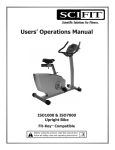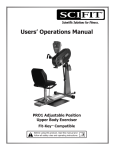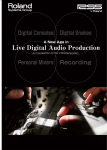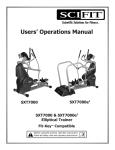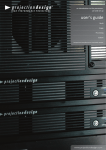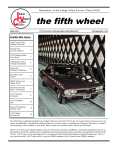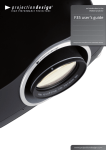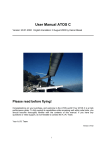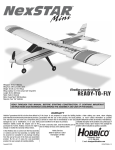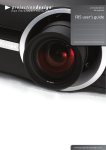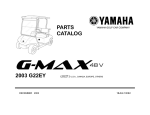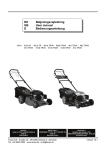Download Ferrari Automobile 512 TR User's Manual
Transcript
Te s t a r o s s a , 5 1 2 T R & F 5 1 2 M A later model Testarossa is easy to spot. Here is a perfect example as the car has two side mirrors and five bolt wheels. Testarossa, 512 TR & F512 M Buyer’s Guide Contents First Published May 2005 by Ferrari Life. Email: [email protected] Copyright 2005 - 2006 ALL RIGHTS RESERVED. Author: William Taylor and Jeff Green 2 5 7 8 9 10 10 13 Introduction & Model Information Driving Impressions Pros & Cons Maintenance & Reliability Buying Tips Ownership Expectations Purchasing Options Model Chart Editor: Andrew Naber Photos by: Bob Hagendijk Ferrari Life | 1 F e r r a r i Buyer ’s Guides by Ferrari Life Model Introduction The Testarossa was Ferrari’s bold statement in an era where overstatement was celebrated. The brief for the Testarossa was heavily focused on addressing the perceived short comings of the understated 512 series Boxers. The Testarossa would need to be able to meet emission and safety standards in all key world markets, carry two passengers in comfort, include enough luggage room for a multi-day trip, and deliver the expected Ferrari performance without requiring the owner to have the driving skills of Nicky Lauda. It also needed to be able to stop pedestrians in there tracks and make heads swivel. At the Paris Motor Show in October 1984, the brief was delivered upon with the introduction of the Testarossa to the world. Pininfarina, for the first time both designed and built the body. The reaction to the new car was anything but muted and it broke new design ground with its overstated aggressive lines. This was the car that would adorn millions of boy’s bedroom walls for the next decade. In 1985 it was the fastest road car on the planet and the first to be powered by a four valve flat 12 cylinder engine. This was the second product from Marranello to carry the Testarossa name, the first being the 250 Testa Rossa race cars from the ‘50s. The name came from the color of the valve covers, usually black but in these two cases, red paint was used instead. In many ways the Testarossa design was a direct result of addressing weaknesses of the 512 Boxers. The signature “cheese grater” side strakes running along the doors into the rear engine compartment actually covered the huge scoops needed to funnel air into the rear mounted radiators. On the 365 GT4 BB & 512 BB, the radiators were front mounted which resulted in the water pipes running under the passenger cabin to reach the mid mounted engine. In the Below: The F512 M had a redesigned rear with round lights and no grille covering them. Opposite page: The Testarossa (top) had a more square front end and lights compared to the newer 512 TR (middle) whereas the F512 M (bottom) was completely different and did not have the pop-up lights of the earlier models. 2 | F e r rari Life Te s t a r o s s a , 5 1 2 T R & F 5 1 2 M summer, this setup could lead to the cockpit turning into a sauna given the effectiveness of the poor air conditioning. Moving the radiators to the sides behind the cabin, also allowed for the creation of a reasonable size luggage compartment in the front of the Testarossa. The simple cabin of the 512 BB was replaced with leather soaked luxury on the Testarossa and outfi�ing the flat 12 engine with “quattrovalvoles” allowed it to meet emission standards everywhere. The wider wheelbase, more advanced lower profile tires, and be�er weight distribution with more weight hung between the axles, improved high speed handling, therefore safely opening more of the cars performance to a wider range of potential owners. The Testarossa went through two major updates during its long 12 year run. These will be covered in detail in the next section. The most significant change was the update to the 512 TR in 1992. The basic mechanicals of the Testarossa are a mid engine configuration using a 180 degree 12 cylinder dual overhead cam 4943cc engine, mated to a 5-speed manual gearbox with a dry double plate clutch. Like the 308 QV, the Testarossa uses 4 valves per cylinder. The Testarossa shares the same basic engine block with the 512 BBi but through revisions to the timing and cooling systems, new cylinder heads, updated Marelli Multiplex ignition system, and Bosch K-Jetronic fuel injection, it develops 50 more bhp for a top speed of 182 mph. The chassis is welded tubular steel with aluminum body panels, except for the doors and roof which are steel. Suspension Ferrari Life | 3 F e r r a r i Buyer ’s Guides by Ferrari Life Specifications General Brakes: Number Made: Chassis: Transmission: Disc, servo assist Testarossa: 7,177 512 TR: 2,280 F512 M: 500 Tubular Steel Dry single-plate clutch, 5-speed + reverse Engine Type: Longitudinal, mid-mounted flat-12 (180 degree V), light alloy cylinder block and head Displacement: 4,942 cc Bore & Stroke: 82 x 78 mm Compression Ratio: Testarossa: 9.3:1 512 TR: 10.0:1 F512 M: 10.4:1 Valve Train: DOHC, 4 valves/cylinder Power: Testarossa: 390 bhp @ 6,800 rpm 512 TR: 428 bhp @ 6,750 rpm F512 M: 440 bhp @ 6,750 rpm Torque: Testarossa: 361 lb/� 512 TR: 491 lb/� F512 M: 500 lb/� Suspension: Front: Rear: Dimensions: Length: Width: Height: Wheelbase: Front/Rear Track: Weight: Performance: Acceleration: Top Speed: Independent, unequal length A arms, coil springs Independent, unequal length A arms, coil springs 4,500 mm 1,710 mm 1,210 mm 2,550 mm 1,460/1,460 mm 1,455 kg 6.5 250 KM/H Ferrari Life’s Rating: 4 | F e r rari Life Testarossa: 2.5 Stars 512 TR: 3 Stars F512 M: 4 Stars is independent unequal length A arms front & rear. Steering via unassisted direct rack-and-pinion and brakes are massive ventilated discs with vacuum servo operating on all four wheels. The steering and suspension set up is heavy at first and handling very linear with a slight understeer. It lightens up with speed. The gear change requires the usual firm hand to slot properly. The leather clad interior detailing and quality is outstanding and significantly more luxurious than its predecessor. The dashboard layout is logical and the dials easy to read at a quick glance. Seats are manually adjustable but a dignified entry/ exit does require a fair amount of dexterity. Unlike the 512 BBi, the front luggage compartment is adequate for a multi day trip. The fuel cap is mounted on the le� rear quarter panel and feeds a 115 liter tank. Throughout its run the Testarossa was the ultimate Grand Touring car. It was able to carry two passengers very comfortable over great distances at high speeds. An impressive 9,957 units were produced over the 12 year model life. Testarossa 1984-1991 Launched in 1984, the Testarossa underwent only a couple of minor changes in the first 8 years. In mid 1988, 2 door mounted rear view mirrors replaced the original single A post driver side mounted mirror, 5 bolt wheels replaced the original single center bolt setup, and a third brake light was added to the rear deck lid. Remarkably for Ferrari, there was only one factory recall during this long run. It was related to problems with the seat belts. An impressive 7,177 units were Te s t a r o s s a , 5 1 2 T R & F 5 1 2 M The word Testarossa literally translate into “Red Head” as Ferrari often paints the engine blocks header red as seen here on the Testarossa. produced. 512 TR 1992-1994 The 512 TR was the first major evolution of the Testarossa. Major changes included a new stronger gearbox which provided for much smoother shi�ing and better durability, lower ride height, a revised interior with more supportive seats, and 18 inch alloys with lower profile tires. The engine was also repositioned and lowered in the chassis which improved handling at the limits by lowering the center of gravity. The front nose was so�ened and now shared the same layout as the 348. As part of the front end redesign, the luggage compartment was enlarged. The ignition and fuel injection systems were upgraded to Bosch Motronic 2.7. The result was 428 bhp at 6750 rpm and a new top speed of 191 mph. F512M 1994-1995 The final evolution of the Testarossa came in 1994 with the introduction of the 512M. Through the use of titanium connecting rods, aluminum alloy pistons, revised exhaust system, and a lighter crank sha�, the same basic 12 cylinder power plant which first powered the 365 GT4 BB in 1974, now produced 440 bhp at 7250 rpm with a new top speed of 196 mph. The huge disc brakes now had ABS assistance and the pop up headlights were replaced by built in pods similar to those later fi�ed to the 550 Maranellono. Changes to the body included the replacement of the rear strakes and rectangular tail lights with the round classic Ferrari lamps, the addition of two NACA ducts on the hood, and a slight reshaping of the front nose. Interior changes included a new steering wheel, aluminum gear shi� knob, aluminum sports pedals, and upgraded climate control system. Driving Impressions By Jeff Green One of the first things you notice about the Testarossa is that there are not any exposed door handles! They are hidden under the top lip of the side strakes, a very stylish solution that preserves Ferrari Life | 5 F e r r a r i Buyer ’s Guides by Ferrari Life The air-intake above is what gives the Testarossa its wide body and classic look. It was not until the F512 M that the rear grille became less prevalent in exchange for round lamps. 6 | F e r rari Life the car’s clean appearance. Once the door is open you will see that the cockpit is very low, the door sill is wide and requires some finess to enter/egress smoothly. Once you are seated the visibility is quite good, even to the rear which is unusual for a midengined sportscar. The seats have the usual adjustments to suit most people unless you are taller than 6’4”, at which point headroom becomes scarce. The steering wheel is adjustable up and down, but does not have a telescoping feature. The driving position is classic Italian where long arms and short legs are a plus. A twist of the key, a “whirring” of the starter and the boxer twelve fires up and se�les to a purring idle of about 1000 Te s t a r o s s a , 5 1 2 T R & F 5 1 2 M rpms. The engine is very smooth with no vibrations at all. It is standard procedure to let the engine run for 30 to 60 seconds to circulate the oil, and then drive the car conservatively until the coolant and oil temps are in their operating range. The clutch requires “medium” effort to operate and is very smooth. The steering is not power assisted, and at slow speeds can be a bit of a work out. Parallel parking is a real challenge testing your arm strength and judgement of distance. It is only recommended once you are very familiar with the car or enjoy replacing body panels Driving in traffic is reasonably easy once you get used to being stared at from everyone around you. The car a�racts a lot of a�ention. You must be keenly aware of others around you as they may be looking at the Testarossa instead of watching the road! At slow speeds the car is a bit heavy and exhibits slight understeer. Get above 30mph and the car seems much lighter and responds very well to steering input. For a car of its size the brakes work well and easily slow the car from any speed. They will not hold up under race track conditions, but for street use they are more than adequate. Antilock brakes were not available on the Testarossa until the 1993 512 TR was introduced. Never the less, the brakes will stop the car without fade or pulling. The shi�er is on the notchy side and takes practice to get smooth gear changes. Like many Ferraris, when the car is cold 2nd gear can be difficult. Many Ferrari owners simply skip 2nd gear until things warm up a bit. The engine seems to have unlimited torque and pulls smoothly from very low rpms all the way up to redline, with power really coming on around 4000rpm. Acceleration is very impressive by any standard. The sound of the engine is intoxicating and you may find yourself pushing it just to hear that twelve cylinder music! A stereo is simply not needed. You do need to mind your speed because the car seems happy to continually go faster. The handling at higher speeds is good, but remember the car is tailheavy and if you are pushing the car near its limits the rear end can slide out with li�le warning. Before you play Mario Andre�i you should practice driving the Pros • It’s a Testarossa, an icon, the dream car of a generation • Will not be mistaken for anything but a Ferrari • Great Drivers car capable of cross continent journeys, truly a grand GT • Reliable, “bullet proof” engine, overall a strong well built Ferrari • Decent trunk space • Has a very passionate following • Great value at current market prices car at a track or closed course. The Testarossa is very forgiving up to a point, but when it does get out of shape it is difficult to get back under control. Here is some advice based on experience with a Testarossas: 1. Do NOT do hard power launches by dropping the clutch! There will be many people who will push you to drop the hammer, but do not give in to their pressure. The gearbox is not designed for this type of abuse. Breaking a transmission mainsha� can be a $20,000 mistake, or in the best case just burning a clutch at about $2,000. 2. Also be careful when going over speed bumps and driveways, it is easy to scrape the nose or bo�om out. And since the rear track is wider than the front, it is easy to scuff a rear wheel going through any areas with tight width restrictions. Overall it is a pleasure to drive the Testarossa. Once you get smooth and familiar with the car it will reward you. And a Ferrari can be a great stress reliever a�er a hard day of work. Cons • Its girth, this is a very wide car • Handling is not exactly nimble • High service costs and frequent intervals • Repairing or replacing major components can be amazingly expensive • Unlikely to appreciate in the near term • Not exactly understated Ferrari Life | 7 F e r r a r i Buyer ’s Guides by Ferrari Life Maintenance & Reliability Build quality on the Testarossa was outstanding by Ferrari standards and the number of recalls during its long life was few and far between. Several issues that have emerged over time are: • Rust on the bo�om of the doors and where the A and B pillars meet. • Water pumps and pump chains on pre 1989 cars. These should have been updated. • Dry seals, gaskets, and O rings, especially if the car has been si�ing • Hoses degrade must be replaced over time. • Paint chips easily • Leather on front dash tray susceptible to shrinkage along the front corners • Testarossa clutches can be weak and wear quickly and should be checked for abuse. 512TR units are stronger. • Warped discs and calipers seizing • Weakness on 2nd gear synchromesh Other potential issues: • Cables for hood and trunk release stretch over time and need replacement • All electrical items: check air-conditioning, power windows, wipers, stereo, lights, etc. • Check that all warning lights come on when starting. • High running temperatures due to clogged air intake vents, or blocked radiators • Rust on the ba�ery tray • CV joints • Hot starting on 512 TR’s due to problems with the solenoid • Flat-spo�ed tires on cars that have been sitting The interior of the car is classic ‘80s with large orange dials in the dash. The interior pictured here is a Testarossa, the later 512 TR and F512 M both had minor updates to modernize the car. 8 | F e r rari Life Te s t a r o s s a , 5 1 2 T R & F 5 1 2 M Buying Tips 1. Demand to see the service book and maintenance history file. Make sure you have solid answers to any major holes in the history. If not, move on. Look specifically for missed cambelt changes. 2. Get the car inspected by a Ferrari trained mechanic. He will find things you miss. Many Testarossa’s were garage queens and lack of use can lead to long list of problems which a PPI should identify. Also check the “cheese grater” side strakes running along the doors to make sure they are straight. If they are not, it is normally a sign of poorly repaired accident damage. Also look for signs of a paint overstray or masking around window seals and trim. 3. If the asking price is very low, there is a reason for it. Major work on Testarossas can exceed the purchase price of the car. In fact a low priced Testarossa may be on the market specifically to avoid a looming major maintenance bill. 4. Carefully check the mileage against the history file. Also do not assume that a two mirror car is a 1988-1992 model. Many early Testarossas were converted to 2 mirror cars in the 90’s. The second added mirror on early cars will be high up on the A pillar. 5. Check the suspension and wheel arches for cracking and abuse. The low ride height and speed bumps can lead to unpleasant surprises. Also the original 16 inches wheels fi�ed to early Testarossas (a�ached via a center bolt) had a reputation for occasionally detaching themselves from the car at speed. This only happened if the tires were not properly rea�ached a�er maintenance and is not due to a design flaw. 6. Never buy the first car you see, look and test drive several. If possible drive both a Testarossa and a 512 TR. Make sure the car starts fairly easily. If thro�le pumping and other dramatic efforts are needed to start the car, run. 7. Make sure the car has all the original books, tools, and records. These are very expensive to replace later. 8. Talk to other owners, join the Ferrari Life. 9. Talk to the Mechanics that have historically serviced the car. If possible also contact prior owners. Ferrari Life | 9 F e r r a r i Buyer ’s Guides by Ferrari Life Ownership Expectations When you purchase a Ferrari, you are not buying a car but rather a work of engineering art and a piece of history. A Ferrari has a soul and character unique in the automotive world. A Ferrari comes filled with Italian passion, for both be�er and occasionally worse. Driving a Ferrari is never boring. It is engaging. You are always involved and interacting with the car across a multitude of senses. While driving, this includes the constantly changing sound track as the engine moves through the rpm range, the heavy but exact clutch, and the metallic click with every gear change. There really is nothing else on the road that sounds like a Ferrari. Until you have driven one, it is impossible to appreciate the totality of the experience. It is this emotional link between car and owner that sets Ferrari’s apart from other sports cars Two other cars that many first time Ferrari owners consider are Lamborghini and Porsche. Lamborghini has similar roots in the Modena area . It however does not have the racing heritage or, for the majority of its life, the single minded guidance of a brilliant owner. Lamborghini’s ownership history has included everyone from Chrysler, an Indonesian Conglomerate, to Audi. This is reflected in the history of the models. Lamborghinis tend to be overly flamboyant, difficult to drive, and highly temperamental. Porsche, on the other hand, is efficient, reliable, and an engineering masterpiece. It is also highly predictable and a�er a time, can be construed as boring. A Porsche does everything with extreme competence, 1 0 | F errari Life to the extent that you begin to wonder if you, the driver, are really needed. The fact is Ferrari’s are expensive to maintain and less reliable than many other cars. This is simply a small part of the deal that comes with being a member of the small and special club of Ferrari owners. The Porsche is a cold rationale machine, a Lamborghini is pure emotion, and a Ferrari gives you both. Purchasing Options In general most Ferrari Buyers purchase their cars at one of four channels: - Official Ferrari Dealers - Independent Specialist Dealers - Private Sellers - Auctions Each has it’s own strengthens and weaknesses. In summary: Official Ferrari Dealers Purchasing through an official dealer will provide the most piece of mind when making the rather considerable investment in a Prancing Horse badged automobile. In almost all cases the car will come with some sort of warranty, a comprehensive service history, and a clean bill of health. All of this comes with a cost and you will likely pay a 10-20% premium vs. other options. One other limitation is that dealers normally only stock the current, plus 1-2 generations of prior models. As a result, dealers are really only an option for the modern (1990’s -) model enthusiast. Independent Specialist Independent Specialist can provide both outstanding service and a wide range of models to choose from, covering all price ranges. Reputation is critical and so is doing your research on an Independent Specialist before writing out a check. Information and insights on different Specialists can be obtained both through your local Ferrari Owners Club members and via posts on the Ferrari Life. Like official dealers, many specialist can provide warranties (via 3rd parties) and on-going maintenance facilities. The quality of the maintenance for modern models can be on par with the official dealers as many independents employee Ferrari trained mechanics. For modern models though it is critical to confirm that the service center has the necessary diagnostic equipment and so�ware (SD1 or SD2) for your model. For Classic and Vintage Ferrari’s, independents many be your only, or best (for more recent models) option. Prices at Independent’s should be 5-20% less than Official Dealers. In most countries, purchasing from either an Official Ferrari Dealer or an Independent Specialist will provide you with the strongest legal rights should anything go wrong. Private Sellers Caveat Emptor. Buying from a private seller is both the lowest cost and highest risk option. In all Ferrari purchases, a Pre Purchase Inspection (PPI) by a specialist is recommended, in the case of a private purchase, it is critical. Purchasing well privately is both a ma�er of form and substance. First the form which is mostly related to general appearance and presentation: - check the condition of the interior, is the leather conditioned and cleaned - pull up the mats, check the con- Te s t a r o s s a , 5 1 2 T R & F 5 1 2 M dition of the under carpet - spray water on the car, make sure it beads up immediately - look in the engine bay - is the owner a member of the local Ferrari Owner’s Club Positives on the above are an initial indication of a careful owner, but could also be the result of a pre-sale clean up. Then move onto the substance: - review the service records, a comprehensive file is always a good sign - check the history of the car, make sure it has always been well cared for - always check that the mileage on the odometer matches the other records - confirm that the seller is the car’s owner and that the title is clear - spend time both test driving the car and talking to the owner. No car is perfect, does the owner point out both the good points of the car and the issues needing a�ention ? Buying from a private seller will provide both the lowest cost of acquisition and the highest risk should any major undisclosed issue emerge post purchase. Doing your homework properly is critical and in many cases it is a rewarding and enjoyable experience for both parties. Auctions As a very broad guideline, cars that appear at auction are either very high value recent models (example – Enzo) or models no longer carried in the Official Dealer network. As per purchasing from a private seller, it is critical to do you homework ahead of time. All auction houses provide for pre-sale viewing but it is very unlikely that a PPI or test drive will be permi�ed. Both need to be included in the buyers purchase risk consideration. Auction Houses act as agents on behalf of the sellers so your legal protection in many countries is not much greater than in the case of a private sale. On the positive side, auctions provide both the opportunity to acquire very rare, unique cars with important histories and other models at a potentially outstanding value. Many Independent Specialist a�end auctions, it is critical that a private buyer understand the environment that he is competing in. Fee schedules differ significantly between the auction houses, so it is strongly advised that these be reviewed ahead of time. Currently the most famous Ferrari Auction is Bonhams December Auction in Gstaad, Swtizerland. Other well know auction houses include: Christies, R&M (North America), Barle� Jackson (North America), Barons (UK), H&H (UK), Coys (UK), and Artcurial (France). F e r r a r i L i f e | 11 F e r r a r i Buyer ’s Guides by Ferrari Life Judgments from The Ferrari Life Team: The following is nothing more than our opinions and should be taken as such. The ratings are meant to provide some guidance but please remember that markets have a logic unto themselves and every Ferrari is a great car in the eyes of its current owner. Rating are: Poor 0 – Excellent 5. Appreciation Potential is based on Market Prices as of June 2005. Ratings Chart Appreciation Potential # Produced (High to Low) Engine Sound Useability Maintenance Cost (Low to High Dino 246 *** *** **** *** **** 308 GT4 308 ** *** * * *** **** *** ** *** *** 308i * * *** *** *** 308QV 328 Mondial 8 Mondial QV Mondial 3.2 Mondial t ** ** * * * * * * * * * ** *** *** ** ** ** ** **** **** *** **** **** **** *** *** *** *** *** *** 348 * * **** *** **** F355 * * **** **** **** 360 Modena 365 GT4 BB * **** * ***** **** ***** ***** ** *** ***** 512 BB 512 BBi *** *** **** **** ***** **** ** *** ***** ***** Testarossa 512 TR F512 M ** ** ** *** *** **** **** **** **** *** *** *** ***** ***** ***** 550 * ** *** ***** ***** 575 365/400/412i 456 GT * * ** ** *** ** *** *** ** ***** **** ***** ***** ***** ***** 456M GT * *** ** ***** ***** Model 1 2 | F errari Life Comments Will always be in demand, gorgeous, one of Pininfarina’s best. A great drive. Beautiful under the skin Fiberglass models command a premium, great carb soundtrack Entry level favorite, performance a bit strangled The best of the 308s One of the best, potential classic An acquired taste Improvements on the 8 Even be�er than the QV The Mondial to have, and the price will reflect this A good buy at current prices, love it or hate it Great, great sports car. One of Pininfarina’s finest. Even be�er than the F355 Best sounding Ferrari period. Very raw and a handful Still raw. Skilled drivers only please. More civilized than the 512 BB but still a handful The ‘80s, wide, loud and fast Improved TR Last mid-engined 12 cylinder. Dated ‘80s car in the mid ‘90s Close to the perfect driving machine. Expense to run. We think the 550 is be�er Cheap to buy, expense to run. Rust prone. The best 2+2 to ever come from Maranello. Very expense to run. Even be�er. Very complex. Te s t a r o s s a , 5 1 2 T R & F 5 1 2 M Comments on the Model Guide from The Ferrari Life Team: Below is a model guide chart to help you be�er understand what models are available and in what configuration. This chart shows a number of cars that are not included in this current book. However, we do have information related to each of the models and to make is more understandable we have color coded the text. • The models marked in red are also available at www.FerrariLife.com/library/guides.php or online at Amazon.com. Any questions related to these Guides should be directed to [email protected]. • The models marked in black do not currently have Guides available but will be made available on a case by case basis. Like the Vintage models we would like to encourage you to visit Ferrari Life if you are in the market for one of these cars and have questions. There are also a number of articles and information related to these models. Buying your first Ferrari can be a daunting task and we hope this will help you along the way. Following this chart you will find the 13 chapters related to each of the model highlighted in dark red. We wish you the best of luck in your search and hope to see you on Ferrari Life a�er a successful purchase. Best Wishes, The Ferrari Life Team Model Guide Seats & Engine Vintage (post 1960) Classic Modern 2 Seats 6 Cylinders 2 Seats 8 Cylinders Dino 206 Dino 246 Not available Not available 308 328 2 Seats 12 Cylinders 250 GT 275 GTB/GTS 330 GTC/GTS 365 GTC/GTS 365 GTB/4 “Daytona” 365 GTS/4 “Daytona” Spider Not available 365 GT4 BB 512 BB/BBi Testarossa 348 F355 360 Modena F430 512 TR F512 M 550 Maranello 575 Maranello 4 Seats (2+2) 8 Cylinders 4 Seats (2+2) 12 Cylinder Supercar 250 GTE 330 GT 2+2 365 GT 2+2 365 GTC/4 250 GTO Dino 308 GT4 Mondial 8/QV & 3.2 365 GT4 2+2 400 412 Mondial t 288 GTO F40 F50 Enzo 456 GT 456M GT 612 Scagle�i Ferrari Life | 13













